In the competitive world of eCommerce, creating impactful product videos is crucial for driving customer engagement and increasing sales. In this article, we outline 10 essential steps to help you produce high-quality product videos that resonate with your audience and boost your conversion rates.
Step 1: Set Clear Objectives
Establish clear goals for your product videos, such as increasing sales, enhancing engagement, or reducing return rates.
Define Your Goals
Identify specific objectives like increasing sales, improving engagement, or reducing returns. Setting measurable targets helps focus your content and assess effectiveness.Establish key performance indicators like view counts, engagement, and conversions to measure video performance.
- Increase conversion rates: Encourage more website visitors to make a purchase after watching a video.
- Improve customer understanding: Help customers grasp product features for better purchasing decisions.
- Reduce return rates: Provide detailed product insights to set accurate expectations and decrease returns.
Identify Target Audience Needs
Understanding your audience is key to creating relatable videos. Conduct research to gather data on preferences, challenges, and buying behaviors.Tailor your content to address specific customer needs, using personalized messaging to resonate with viewers and build engagement.
- Conduct customer research: Gather data on demographics, interests, and buying behavior.
- Identify pain points: Find common challenges your product can solve.
- Personalize your message: Create content that speaks directly to your audience's needs.
Step 2: Choose the Right Products
Select visually appealing products that benefit from being demonstrated and focus on highlighting their unique selling points.
Select Visually Appealing Items
Focus on visually striking products or those that benefit from being demonstrated. Highlight textures, colors, and dimensions to give shoppers a realistic feel. Visually appealing products grab attention and increase the chances of converting viewers into buyers.
Highlight Unique Selling Points
Identify and emphasize the features that set your product apart from competitors. Show how your product solves specific customer problems, focusing on benefits rather than just technical features.This makes your video more compelling and encourages customers to choose your product.
- Show real-world examples: Demonstrate how your product meets customer needs.
- Focus on benefits: Highlight how the product solves problems or improves lives.
- Emphasize unique features: Show what makes your product stand out from competitors.
Step 3: Showcase Product Features
Present product features concisely, using comparisons to help customers make informed purchasing decisions.
Create Concise Videos
Keep videos short and engaging. According to Videoly, videos between 30 seconds and two minutes are ideal for maintaining interest. Concise videos respect your audience's time and ensure they stay focused on the product's key benefits and features.
Include Comparisons
Comparing your product to competitors helps customers make informed decisions. Highlight key advantages in performance, features, or value. Comparison videos build confidence and can persuade customers that your product is the best solution for their needs.
- Compare performance: Show how your product outperforms competitors in key areas.
- Highlight value: Emphasize cost-benefit comparisons to show value for money.
- Demonstrate features: Focus on advantages that solve specific customer problems.
Step 4: Optimize for Platforms and Devices
With the evolution of video commerce, it's essential to optimize your product videos for various platforms and devices to maximize their impact.
Ensure Cross-Compatibility
Your videos must perform well across smartphones, tablets, and desktops. Test videos on different devices to ensure seamless playback. Use responsive designs that adjust to different screen sizes, ensuring that your content is accessible to all viewers.These steps are essential for boosting engagement with video across all platforms.
- Test across devices: Play videos on different devices to check for playback issues.
- Use responsive designs: Ensure your video layout adjusts to screen size and orientation.
- Optimize visual clarity: Use large, readable text and clear visuals suitable for smaller screens.
Implement SEO Techniques
Optimize your videos for search engines to increase visibility and traffic, helping to improve SEO with video. Use keyword-rich titles, descriptions, and tags, and provide transcripts for better SEO.Hosting videos on platforms like YouTube can enhance discoverability and drive organic traffic to your store.
- Use keyword-rich titles: Include relevant keywords to improve search ranking.
- Provide transcripts and captions: Add text to improve SEO and accessibility.
- Optimize for each platform: Tailor content for specific platform SEO dynamics.
Step 5: Structure Your Product Videos Effectively
Organize your content logically and end with a compelling call-to-action to guide viewers toward making a purchase.
Organize Content Logically
Begin with a strong introduction and demonstrate real-world use cases. Highlight the product's benefits, not just its features, and use storytelling techniques. Present the problem, show how your product solves it, and emphasize key benefits.
End with a Clear Call-to-Action
Conclude with a direct, compelling call-to-action (CTA) that encourages viewers to take the next step. Make your CTA simple and easy to follow, using visual cues and clear language to drive conversions.
- Make the CTA clear: Use direct language that clearly states the next step.
- Reinforce with visuals: Add visual elements to emphasize the CTA.
- Encourage urgency: Use phrases like “Shop Now” or “Limited Offer” to prompt action.
Step 6: Use Different Types of Product Videos
Cater to different customer preferences by utilizing various types of product videos.
Demonstration Videos
Show your product in action, highlighting its features and benefits. Focus on real-world use cases and include close-up shots to emphasize important details. Demonstration videos help customers see how your product works and why it's valuable.
Unboxing and UGC
Unboxing videos create excitement by showcasing the discovery process. Encourage customers to create their own unboxing videos to build trust and credibility. User-generated content helps potential buyers see authentic experiences with your product.
- Show real-life scenarios: Display how customers use and enjoy your product.
- Encourage user content: Incentivize customers to share their unboxing experiences.
- Show packaging details: Highlight unique packaging aspects that enhance the experience.
Step 7: Filming Tips
Focus on quality production by using proper equipment and stabilizing shots to enhance video professionalism and appeal.
Gather Essential Equipment
Investing in quality equipment like a good camera, lighting, and microphone is a crucial video content creation step to enhance video quality. Proper equipment ensures clear visuals and audio, making your videos more polished and professional, which boosts viewer engagement.
Stabilize Shots
Stable footage is essential for a polished look. Use tripods or gimbals to maintain steady shots, and avoid handheld shooting to prevent unsteady footage. Stability enhances the viewer's experience and makes the video more visually appealing.
- Use a tripod: Keep the camera steady to avoid shaky footage.
- Use stabilizers: Gimbals help keep the shot steady during movement.
- Avoid handheld shooting: Unsteady footage can be distracting and reduce quality.
Step 8: Focus on Audience Engagement
Craft engaging, natural scripts that speak directly to your audience’s needs and create emotional connections with viewers.
Speak to Your Audience
Tailor your video content to address specific audience challenges and desires by implementing effective customer engagement strategies. Show how your product solves real-world problems, and use language and scenarios that resonate with your customers. Personalizing the content improves viewer connection.
Create a Natural Script
Write in a conversational tone that aligns with your brand's voice. Avoid overly formal language and aim for authenticity. A natural, engaging flow helps keep viewers interested and ensures your message is clear and memorable.
- Write conversationally: Keep the tone approachable and authentic.
- Focus on benefits: Highlight how your product meets specific needs.
- Engage emotionally: Connect with the audience by addressing real problems.
Step 9: Incorporate Customer Testimonials
Feature customer testimonials to build trust and credibility, leveraging social proof to drive conversions.
Build Trust and Credibility
Showcase satisfied customers sharing their experiences with your product. Testimonial videos offer real-world validation that helps build trust in your brand. Seeing others' positive experiences encourages new customers to make a purchase.
Leverage Social Proof
Incorporating testimonials into your videos is a crucial part of digital engagement solutions, enhancing trust and driving conversions. Testimonials serve as powerful social proof that influences buying decisions.Showing real customers using and enjoying your product provides authenticity and demonstrates its value to potential buyers, which drives conversions.
- Use real customers: Feature authentic customer experiences to build trust.
- Showcase product usage: Show how your product solves real-life challenges.
- Highlight positive results: Focus on how your product improved customers' lives.
Step 10: Analyze and Improve
Track video performance metrics and make data-driven improvements to refine your strategy and increase conversion rates.
Gather Analytics
Track metrics like view count, watch time, and conversion rates to gauge success. Regularly review these metrics to understand what works and identify areas for improvement.
Iterate Based on Feedback
Use insights from analytics to refine your video strategy. Experiment with different styles, optimize content length, and enhance calls-to-action based on audience feedback. Continuously improving based on data ensures better engagement and conversions.By following these steps and making data-driven improvements, you can effectively increase conversion rate.
- Track key metrics: Monitor view counts, watch times, and conversion rates.
- Refine content based on data: Use analytics to adjust your approach.
- Experiment with styles: Test different formats and lengths to see what works best.
Unlock Exclusive Insights
By submitting this form, you agree to Firework's privacy policy and consent to receive personalized marketing communications. You can unsubscribe at any time.





























